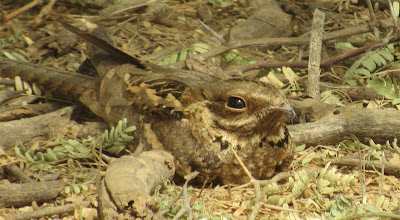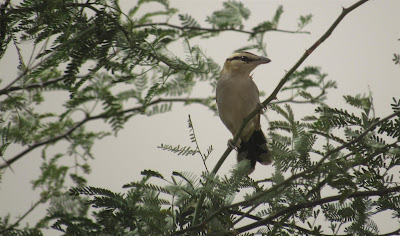We took all day to return. We passed both fishing hamlets in Diawling on the way out of the National Park for one last time but not without stopping at both.
We were still looking for giant kingfisher which is known to like these locations. Again we failed to spot one.
pied kingfisher
three pied kingfisher
We got our best views of African spoonbill at the first hamlet too. Though these were still distant.
African spoonbill
In contrast a group of great white pelican came up close to shore.
great white pelican
The big attraction for the birds at the hamlets is clearly fish. For the gulls it is dried fish.
grey-hooded gull
The fishermen didn't seem to bother as a grey-hooded gull walked over some drying catch.
juvenile black-crowned night heron
Two other birds were seen eating live fish. The first was a juvenile black-crowned night heron.
long-tailed cormorant
The second was a long-tailed cormorant which was fishing in shallow water.
many African swamphen
Between the two hamlets, we found an area with a high density of African swamphen.
At the second hamlet, this time there were far closer views of a yellow-billed stork than elsewhere on the trip.
yellow-billed stork (left)
There was also an opportunity to see several black crake for longer than before.
black crake
The best bird came from an unexpected quarter. It was an African reed warbler which was foraging around and in a tamarisk bush.
African reed warbler 1
African reed warbler 2
Whilst these factors are already enough to clinch its identification, the fact that it chose tamarisk to spend 15 minutes while next to extensive reed beds is also of some import. African reed warbler will take to drier terrain than Eurasian reed warbler. I saw several African reed warbler (and some tawny-flanked prinia) in similar Tamarisk just the other side of the Senegal River in Saint Louis in early May 2017.
African reed warbler 3
.
African fish eagle
African mourning dove
We got one last good close look at African mourning dove which is the dominant dove of the wetter parts of the park.
There is one final open stretch of water before the terrain becomes marshland, then grassland then semi-desert over a few kilometres (along the north east road out of the park).
black stork
Here we had our best views of wintering black stork.
Eurasian spoonbill and pied avocet
garganey
Try as we might, we never found any Palearctic small or medium duck other than garganey. The larger ones were common shelduck, northern shoveller and also northern pintail but on day one only.
gull-billed tern
Still no marsh terns were seen either, although Caspian tern, gull-billed tern and a small number of sandwich tern were regularly seen.
Finally outside the national park, we elected to take the river road to Rosso rather than the more northerly route through Kaur Macene.
Much of the route to Rosso consisted of semi-desert with tamarisk on the left and impenetrable reed beds on the right.
It was only when we reached within 25 kilometres of Rosso that irrigation channels and farming began to provide a landscape amenable to most birds. At the very beginning of this new habitat we found a row of tall trees next to the River's reed beds. We managed to accidentally flush over 100 sleeping black-crowned night heron. It was also the only one of two places over the weekend where we found red-billed firefinch.
Our only other stop in this area west of Rosso was at an abandoned palm plantation where land remediation is not really complete.
Despite this, we flushed no few than six long-tailed nightjar having just got out of the car.
long-tailed nightjar 1
long-tailed nightjar
The pools and very close by to them were the best places for birds at the old palm plantation. Other areas are still too degraded. More red-billed firefinch were observed. In the water, little stint, greenshank, ruff and marsh sandpiper were found. Marsh sandpiper is a Russian bird and not many come through Nouakchott from this very eastern breeding area. Yet in the south west corner of Mauritania they proved not uncommon.
marsh sandpiper
short-toed snake eagle (photo:Mohamed Vall)
The area from Rosso and eastward along the Senegal River is a major wintering place for short-toed snake eagle. Though we were at the extreme western edge of this strip, we saw one.
At our stop, we came across a watering hole which was almost dry but which is fairly obviously quite large in the rainy season and had lasted over three months since it finshed.
African silverbill
Elsewhere laughing dove and Namaqua dove were numerous and obvious.
Namaqua dove
black-crowned tchagra
We got close and prolonged views of a group of cricket longtail.
cricket longtail 1
This was effectively the last bird we sighted on an eventful long weekend south. I ended up with a Mauritanian list twelve higher at 292. The so called "line of shame" of 300 species (as invented in the UAE as the name of a target which proves one has extensively birded a Middle Eastern North African country) is within my grasp.
cricket longtail 2
I got even closer to the line of shame in Nouakchott last weekend. For the first time in months I added two birds to my country list in the city. I will blog about that next.





























No comments:
Post a Comment